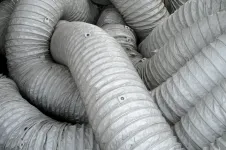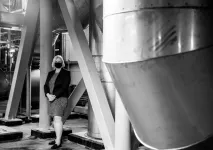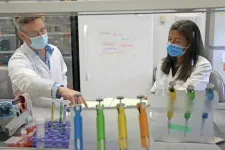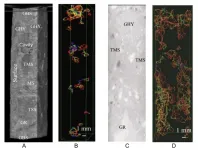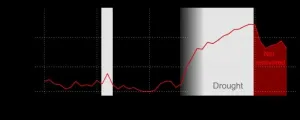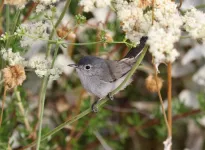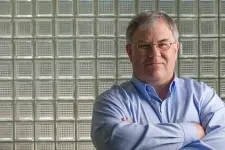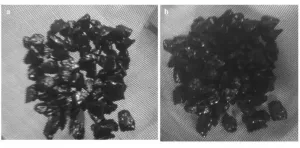(Press-News.org) Humans in the 21st century spend most of their time indoors, but the air we breathe inside buildings is not regulated to the same degree as the food we eat and the water we drink. A group of 39 researchers from 14 countries, including two from the University of Colorado Boulder, say that needs to change to reduce disease transmission and prevent the next pandemic.
In a Perspectives piece published in Science May 14, they call for a "paradigm shift" in combating airborne pathogens such as SARS-CoV-2, the virus that causes COVID-19, demanding universal recognition that respiratory infections can be prevented by improving indoor ventilation systems.
"Air can contain viruses just as water and surfaces do," said co-author Shelly Miller, professor of mechanical and environmental engineering. "We need to understand that it's a problem and that we need to have, in our toolkit, approaches to mitigating risk and reducing the possible exposures that could happen from build-up of viruses in indoor air."
The paper comes less than two weeks after the World Health Organization (WHO) changed its website to acknowledge that SARS-CoV-2 is spread predominantly through the air, and 10 months after the WHO acknowledged the potential for aerosol transmission and 239 scientists (including Miller and Jose-Luis Jimenez) signed an open letter to medical communities and governing bodies about the potential risk of airborne transmission. The researchers now call on the WHO and other governing bodies in this new article to extend its indoor air quality guidelines to include airborne pathogens and to recognize the need to control hazards of airborne transmission of respiratory infections.
Such a shift in ventilation standards should be similar in scale to the 19th century transformation that took place when cities started organizing clean water supplies and centralized sewage systems. But it would also correct a major scientific misperception that arose around the same time.
When people in London were dying of cholera in the 1850s, scientists assumed the disease was airborne. But British physician John Snow discovered that microorganisms in contaminated water were the reason. Similarly, Hungarian physician Ignaz Semmelweis showed that handwashing before delivering a baby greatly reduced postpartum infections. While these discoveries encountered great resistance in their time, scientists eventually agreed that in these cases, water and hands--not air--were the vector for disease.
Then in the early 20th century, American public health expert Charles Chapin erroneously attributed respiratory infections caught in close proximity to other people to large droplets produced by an infected person, which fall quickly to the ground. As a result, he stated that airborne transmission was almost impossible.
Yet in 1945, scientist William Wells published a paper in the predecessor to Science, lamenting that while we were investing in disinfecting water and keeping our food clean, we had done nothing for our indoor air, given the denial of airborne transmission. His research on measles and tuberculosis--caused by airborne pathogens--challenged this notion in the 20th century, but didn't break it.
Now that the research on SARS-CoV-2 finally has brought to light that many respiratory diseases can be transmitted through the air, researchers argue that we must take action.
"Let's now not waste time until the next pandemic," said said co-author Jose-Luis Jimenez, fellow in the Cooperative Institute of Research Sciences (CIRES) and professor of chemistry at CU Boulder. "We need a societal effort. When we design a building, we shouldn't just put in the minimum amount of ventilation that's possible, but instead we should keep ongoing respiratory diseases, such as the flu, and future pandemics in mind."
The long-standing misunderstanding of the importance of airborne transmission of pathogens has left a large gap of information in how to best construct and manage building ventilation systems to mitigate the spread of disease--with the exception of some manufacturing, research and medical facilities. Instead, buildings have focused on temperature, odor control, energy use and perceived air quality. So while there are safety guidelines for chemicals such as carbon monoxide, there are currently no guidelines, globally or in the U.S., that regulate or provide standards for mitigating bacteria or viruses in indoor air resulting from human activities.
"Air in buildings is shared air--it's not a private good, it's a public good. And we need to start treating it like that," said Miller.
Lidia Morawska, lead author on the article and director of Queensland University of Technology's International Laboratory for Air Quality and Health, said there needs to be a shift away from the perception that we cannot afford the cost of control. She notes that the global monthly cost from COVID-19 had been conservatively estimated as $1 trillion and the cost of influenza in the U.S. alone exceeded $11.2 billion annually.
While detailed economic analysis has yet to be done, estimates suggest necessary investments in building systems may be less than 1% of the construction cost of a typical building.
Ventilation systems should also be demand-controlled to adjust for different room occupancies, and differing activities and breathing rates, such as exercising in a gym versus sitting in a movie theatre, according to Morawska. For spaces that cannot improve ventilation to an appropriate level for the use of the space, she said air filtration and disinfection will be needed.
Because buildings consume over one-third of energy globally, much from heating or cooling outdoor air as it is brought indoors, it would be useful to design a "pandemic mode," that would allow for buildings to only use more energy when necessary, said Jimenez.
The researchers also call for national comprehensive indoor air quality (IAQ) standards to be developed and enforced by all countries, and for this information to be available to the public.
For this to happen, however, many more than scientists will need to understand its importance.
"I think there is a certain amount of demand that needs to start coming from the consumer and from the person who works in these indoor spaces in order to push change," said Miller.
INFORMATION:
UNIVERSITY PARK, Pa. -- A plant cell wall's unique ability to expand without weakening or breaking--a quality required for plant growth--is due to the movement of its cellulose skeleton, according to new research that models the cell wall. The new model, created by Penn State researchers, reveals that chains of cellulose bundle together within the cell wall, providing strength, and slide against each other when the cell is stretched, providing extensibility.
The new study, which appears online May 14 in the journal Science, presents a new concept of the plant cell wall, gives insights into plant cell growth, and could provide inspiration for the design of polymeric materials with new properties.
"For a long time, the prevailing ...
Curiosity is the motivational drive for exploring and investigating the unknown and making new discoveries. It is as essential and intrinsic for survival as hunger. Until recently, the brain mechanisms underlying curiosity and novelty seeking behavior were unclear. However, researchers from the Netherlands Institute for Neuroscience have now discovered a new brain circuit underlying curiosity and novelty seeking behavior. The results have been published in the scientific journal Science.
Curiosity, hunger and appetitive aggression drive three different goal-directed behaviors: novelty seeking, food eating and hunting. In animals these behaviors are composed of similar actions. This similarity of actions has made it challenging ...
A group of the world's leading experts in the transmission of airborne pathogens is calling for a tightened regulatory system to control air quality in buildings - as a way of reducing the spread of covid-19 and other illnesses.
Writing in the journal Science, the 40 scientists say: "A paradigm shift is needed on the scale that occurred when Chadwick's Sanitary Report in 1842 led the British government to encourage cities to organise clean water supplies and centralised sewage systems.
"In the 21st century we need to establish the foundations to ensure that the air in our buildings is clean with a significantly reduced ...
Epidemic. Pandemic. These terms have become second nature to us, popping up in everyday conversation, and for good reason -- COVID-19 is the latest pandemic to pose a threat to humanity.
But in recent months, far less attention has been paid to another widely spread problem that has been proliferating since the late 1970s: Lyme disease.
Lyme disease is the most reported vector-borne disease in the country. Over the past 20 years, the United States has experienced a dramatic increase in both the number of reported cases and the geographic distribution of the disease. In Virginia, the disease is transmitted by blacklegged ticks, which are infected with the Lyme disease-causing bacterium Borrelia ...
Scientists reveal that the deterioration of modern concrete and asphalt structures is due to the presence of trace quantities of organic matter in these structures.
Cement and asphalt are vital to modern construction materials; cement is used for the construction of various buildings and structures, while asphalt is primarily used for highways and runways. They have been widely used for these purposes since the 1800s. It has been observed modern concrete structures and asphalt structures tend to deteriorate much faster than historical structures, but the reason for this phenomenon was unknown.
A team of scientists from six institutions, including Akihiro ...
One-third of the water catchments included in a Victorian study had not recovered from a severe drought nearly eight years later, Australian-first research from Monash University shows.
Globally, science holds the common view that rivers and underground water supplies eventually replenish following periods of severe drought or flood.
This study, led by Dr Tim Peterson from Monash University's Department of Civil Engineering and published today in the prestigious international journal Science, is the first in the world to challenge this widely held view.
Researchers used statistical ...
A new approach to genomic species delineation could impact policy and lend clarity to legislation for designating a species as endangered or at risk.
The coastal California gnatcatcher is an unassuming little gray songbird that's been at the epicenter of a legal brawl for nearly 28 years, ever since U.S. Fish and Wildlife Service listed it as threatened under the Endangered Species Act.
Found along the Baja California coast, from down south in El Rosario, Mexico to Long Beach, Calif., its natural habitat is the rapidly declining coastal sagebrush that occupies prime, pristine real estate along the West Coast. When this particular gnatcatcher, Polioptila californica, was granted protection, the region's real estate developers went to court to get it delisted. ...
Viruses require the resources of an infected cell to replicate and then infect further cells, and transfer to other individuals. One essential step in the viral life cycle is the production of new viral proteins based on the instructions in the viral RNA genome. Following these construction plans, the cell's own protein synthesis machine, called the ribosome, produces the viral proteins.
In the absence of viral infection, the ribosome moves along the RNA in strictly defined steps, reading three letters of RNA at a time. This three-letter code defines the corresponding amino acid that is being attached to the growing protein. It almost never happens that the ribosome slips one or two RNA letters forward or backward instead of following the regular three-letter steps. When such a slip ...
Irvine, CA - May 13, 2021 - A new University of California, Irvine-led study finds low serum levels of the sugar N-acetylglucosamine (GlcNAc), is associated with progressive disability and neurodegeneration in multiple sclerosis (MS).
The study, done in collaboration with researchers from Charité - Universitätsmedizin Berlin, Germany, and the University of Toronto, Canada, is titled, "Association of a Marker of N-Acetylglucosamine With Progressive Multiple Sclerosis and Neurodegeneration," The study was published this week in JAMA Neurology.
The study suggests that GlcNAc, which has been previously shown to promote re-myelination and suppress neurodegeneration in animal models of MS, ...
First co-author, Junior Research Associate of the Rheological and Thermochemical Research Lab Richard Djimasbe, comments, "To obtain bitumen as a half-solid product from heavy oil, you have to extract light fractions, and the rest is non-oxidized bitumen. Because of the relatively low ratio of light fractions in heavy oil, it's a simple and cheap way of bitumen production. The method allows for rational use of both heavy oil and light oil."
Lab Head Mikhail Varfolomeev adds, "One of the priorities of our World-Level Research Center in Liquid Hydrocarbons is the use of heavy oils, which constitute the majority of reserves both in Russia and in the world. One of the most important parts of this is extraction and refining of heavy ...
